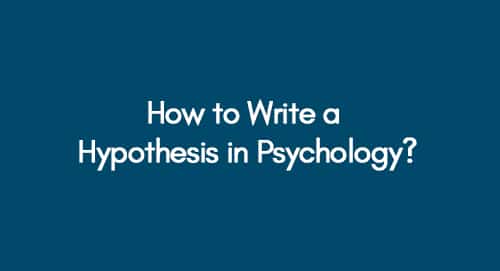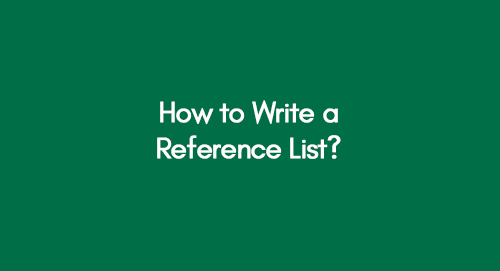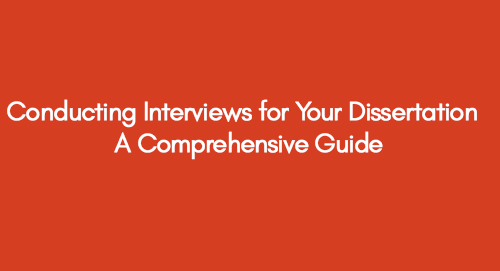
How to Write a Hypothesis in Psychology | A Step-By-Step Guide
October 10, 2022
How to Write Data Analysis and Findings: A Comprehensive Guide to Interpreting Result
October 10, 2022When crafting a research paper, it holds significance to incorporate a comprehensive list of references, encompassing all the sources utilized in its creation. However, the question arises: How does one go about constructing a reference list? What guidelines should be followed to ensure optimal practices?
Explore Current Dissertation Topics Here
Learn with Our Expert Dissertation Examples
The following guide will cover the basic and advanced methods of how to write a reference list and various styles of creating a reference list.
Get 3+ Free Custom Topics within 24 hours;
What is a Reference List?
A reference list is an index of sources consulted during research or academic writing. The reference list typically appears at the end of the paper and includes all of the sources that have been cited in the text. Reference lists can be arranged alphabetically or chronologically, depending on the style guide.
Explore More About Annotated Bibliography Here
Learn in Detail About Dissertation References
Reference lists are essential to academic writing, as they allow readers to engage with consulted sources and follow up on those sources if required. In addition, reference lists demonstrate the breadth of research. Academic papers necessitate the inclusion of a reference list for grading and approval.
The Format of a Reference List
The following pointers will help you format your reference list in the best way possible:
- The reference list should be added at the end of your academic piece. Label the page as "references" in bold. It gives your audience the information required to find and retrieve any sources you mention in the body.
- Each source referenced in your article must be included in the reference list, and every entry should be cited in the research text.
- There are many different ways to format a reference list, but the most common style is to use hanging indents. This means that the first line of each reference is flush with the left margin, while all subsequent lines are indented one-half-inch.
- Your references should be alphabetically listed based on the first letter of the reference.
- You should invert all the authors' names by writing the last name first. While authors' first and middle names must be written as initials. For example, "John William Smith" must be written as "Smith, J. W" in the referencing.
- In the case of multiple authors, alphabetize according to the first author's last name followed by the other authors' initials. If no author is listed, alphabetize by the first word of the title.
- Finally, use consistent punctuation and capitalization throughout your reference list. All references should end with a period, and titles should be capitalized using sentence case (only capitalize the first word and proper nouns).
Types of Referencing Styles
There are many ways to reference the sources you use in your work. The style you choose will depend on the journal you are submitting to and your preferences. The three most common referencing styles are APA, MLA, and Chicago. Many other less common referencing styles exist, such as Harvard, Oxford, and Vancouver. Let's consider various styles of how to write a reference list.
1- Harvard Referencing Style
Harvard referencing style is widely used in many disciplines, including the humanities, social sciences, and natural sciences. It is an (Author, Date) referencing system with multiple variations.
- Harvard style also requires a reference list at the end of your work, which provides full details of all your cited sources. This includes the author's name, the date of publication, and the full name of the article. An example of the Harvard referencing list entry is "Einstein, A., 1922. The general theory of relativity. In The Meaning of Relativity (pp. 54-75). Springer, Dordrecht."
- The technique cites the author's name and publication date in parentheses after a quote or reference. For in-text citations,s the example could be: "Einstien (1922) argued that determined that the laws of physics are the same for all non-accelerating observers." Another example is: "Albert Einstein, in his theory of special relativity, determined that the laws of physics are the same for all non-accelerating observers (Einstien, 1922)."
2-Chicago
Chicago style is typically used in history and social science writing, although it can be used in other disciplines.
- Chicago is referenced in an "author-date" style. The citation in the text consists of the author(s) name and year of publication enclosed in round brackets. Use just the author's surname and the year of publication. If you need to be particular, include the page number(s), chapter, or section numbers. Separate the names with a comma.
- On the other hand, In Chicago book citation, you must consider the Author's first name, last name, Title of Book (Place of publication: publisher, year), and page number(s). Following is the example for the Chicago book referencing list entry:
The reference "Smith, Zaidi. 2016. Swing Time. NewYork: Penguin Press" could be cited as (Smith 2016, 315-160)
3- MLA
MLA referencing style is a style guide usually used by scholars in the field of humanities when writing research papers. MLA style uses parenthetical in-text citations and a Works Cited page at the end of the paper to provide comprehensive information about sources.
- MLA style consists of two significant parts. MLA in-text citations are brief references made within the text, while MLA Works Cited list tabulates details cited sources. An example of MLA referencing list entry is James, Anthony C., et al. "Cognitive behavioral therapy for anxiety disorders in children and adolescents." Cochrane Database of systematic reviews 11 (2020).
- In MLA in-text citation style, You must use the author's last name and the page number from which the text is taken, for example: (James 267). If no page numbers are given in the source, do not include a number in the parenthetical citation: (James).
4-APA
APA referencing style is a parenthetical author-date style, meaning that you must put the author’s last name and the publication date into parentheses while citing sources. The American Psychological Association (APA) style is extensively used for citing sources in academic papers in scientific and social science writings such as Engineering, Medicine, and humanities.
- The APA Referencing style guide provides guidelines for two types of APA references:
- APA citations for print sources: Print sources would include a book, a report, or a scientific journal
- APA citations for electronic sources include a website, articles from an online database, or email.
- The following example showcases the use of in-text APA Citation
- Intext Citation example: the patient's health improves by 50% by using medicine X in Y concentration (Downing et al., 2002; Pricking, 1990.)
- Reference List Entry: Downing, S.M., Mitshyui, M. S., & Collin, C. S. (1880). Analyzing effects of herbal medication on Malaria patients. Journal of Medicine and physiology, 20(3), 195-199.
Basic Rules for Sources
- In-text citations must be used whenever you use a source, whether quoting, paraphrasing or summarizing.
- Each in-text citation must correspond to a full reference at the end of your paper.
- The full reference for each source must include all the information necessary for someone to find the original source. This includes the author(s), date, title, and publication details.
- All references must be formatted according to the specific guidelines of the chosen referencing system.
- You may also need to include a bibliography at the end of your paper, which is a list of all the sources you used, even if you did not cite them directly.
Basic Rules for Articles in Academic Journals
- All articles published in academic journals must be properly referenced.
- The reference list should be included at the end of the paper.
- All references must be listed alphabetically by author's last name.
- For each reference, include the author's last name, first initial, year of publication, article title, journal name, volume number, and page numbers.
- References should be double-spaced and use a hanging indent (first line flush with the left margin, subsequent lines indented).
Review the Following:
- How to Write References: Best Tips and referencing style examples
- How to Write Academically?
- How to write an academic essay: Tips and examples
Need us to help with your referencing list?
Properly sourcing and citing your references is an essential part of academic writing. At Premier Dissertation, we understand the importance of a well-formatted reference list and are here to help you get it done right. We offer comprehensive referencing services that will take care of all the details for you so that you can focus on what’s important – writing your paper. Contact us today by simply dropping us a message on Whatsapp or by Email if you want to learn more about our referencing services, and we will get back to you within 24 hours. We would be pleased to help you in any manner we can. Thanks again for reading!
Get an Immediate Response
Discuss your custom requirements with our writers
Free Online Plagiarism Checker For Students
We will email you the report within 24 hours.
Upload your file for free plagiarism





























